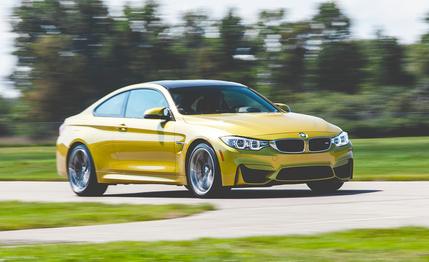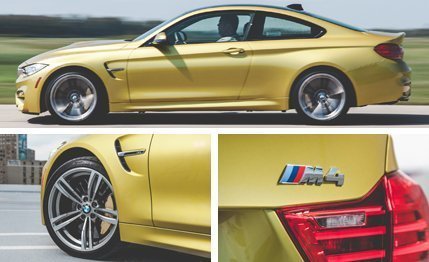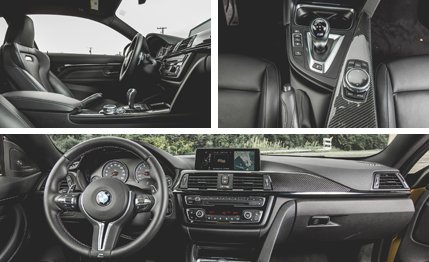
 Instrumented Test
Instrumented Test
Mick famously preaches that you can’t always get what you want, which couldn’t be truer of the new BMW M4—and in more ways than one. We’d hoped to test a model without the $8150 carbon-ceramic brakes and $1000 adaptive dampers because we wanted to see how a more affordable M4 ($70,000 or so) would fare. Unfortunately, that will have to wait: Every single M3/M4 (which isn’t an algebraic way of expressing three-quarters) currently in the BMW press fleet is fitted with the pricey grabbers.
All isn’t lost. We were able to run our gamut of tests on the twin-turbo M4 at our home proving grounds, where this example proved a little quicker, a little grabbier, and a little heavier than the M4 we recently put up against a Porsche 911 down South. The launch-control program bundled with the $2900 dual-clutch automatic transmission is difficult to engage, and if the car isn’t happy with engine or transmission temperatures, it won’t go into hole-shot mode at all. More annoying was that we never could be sure whether the problem was with temperatures or some lapse in following the fussy procedure. At least the transmission responds to commands without delay.
Nearing our give-up point, we turned back to the owner’s manual and upon re-reading found that the car must have “uninterrupted driving of at least 6 miles” before launch control is available. So, warm it up with a run to the store for a six-pack first. Here’s the sequence to engage launch control: turn off stability control, select the transmission’s most aggressive mode, hold your left foot on the brake pedal, and mash the accelerator. At this point, the engine revs up and a checkered flag appears in the instrument cluster. Launch rpm is adjustable in 500-rpm increments by using, obviously, the cruise-control system.


We found the best launch at about 2500 rpm (just north of the 406-lb-ft torque peak at 1850 rpm) after a quick burnout to clean off the Michelins. The result was a 0-to-60-mph time of 3.7 seconds and a quarter-mile of 12.0 seconds at 119 mph. That’s 0.2-second quicker to 60 mph and 0.1 quicker in the quarter than the other M4 DCT we’ve tested. Skidpad grip was an even 1.00 g, up 0.02, and a panic stop from 70 mph took 150 feet, one shorter than before. For the record, this car was 34 pounds heavier, at 3615.
Even with those numbers—better than the ones turned in by the Cadillac CTS-V coupe, the new 2015 Lexus RC F, the old Mercedes-Benz C63 AMG, and the Audi RS5—the M4 isn’t as close to a perfect car as was its M3 coupe predecessor. Nearly all M4 gripes center on how the car feels. The steering has taken a dose of Novocaine. Even with the adaptive dampers, the ride is jarring and the firmness setting reverts to Sport mode when the ignition is cycled. Every time you get in the car you have to set suspension, steering, and engine adjustments to your liking. Your favorite combination can be loaded into one of the “M” buttons to make this a one-touch deal, but it’s another thing to do. It’s not as annoying as having your TV select Lifetime every time you flip it on, but still.


We’d much prefer a car with slightly lower limits that’s more comfortable in everyday use. That’s what made the older M3s so special. That car was as docile as a golden retriever until the driver said “fetch,” and then it got down to business.
Most of our editors also find the engine note too artificial. We investigated and found that if you pull a 40-amp fuse to the stereo, all the extra sounds that BMW intertwines with the natural noises are cut. This isn’t the most practical solution because then there is no radio, but without the speakers, everything you hear is genuine engine. Sure, the turbos muffle it a bit, but at full tilt with the windows open the glorious sounds of the 425-hp inline-six fill the cabin. We’ll bet an aftermarket crew will figure out how to deactivate the backing track.
There is one equation that this car produces that we think rings true:
(1.00g+150-ft stopping) x 12.0-second quarter = All the Car You’ll Ever Need.
If only the objective measures were accompanied by a little bit more of that old-timey M3 feel, this car would prove Mr. Jagger wrong.